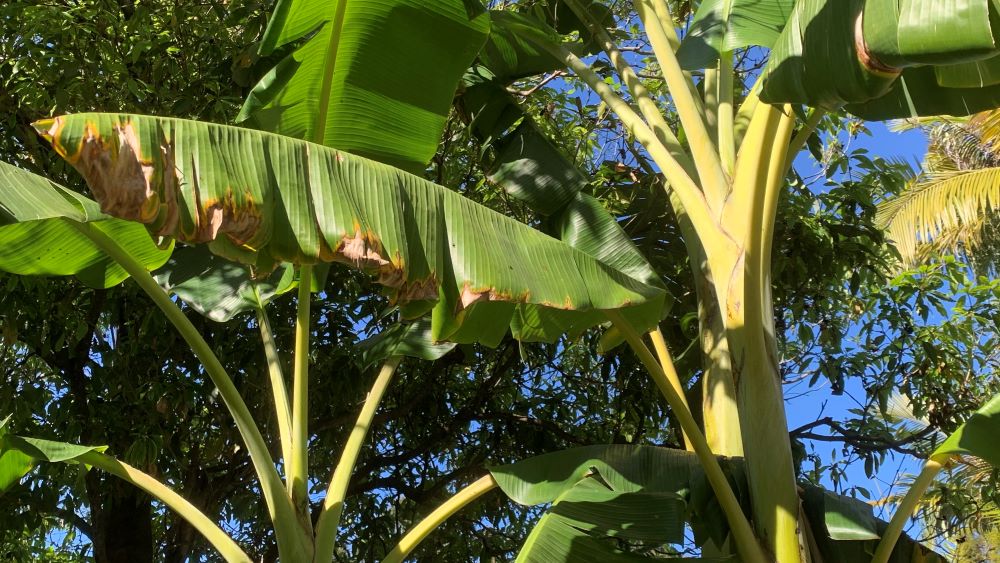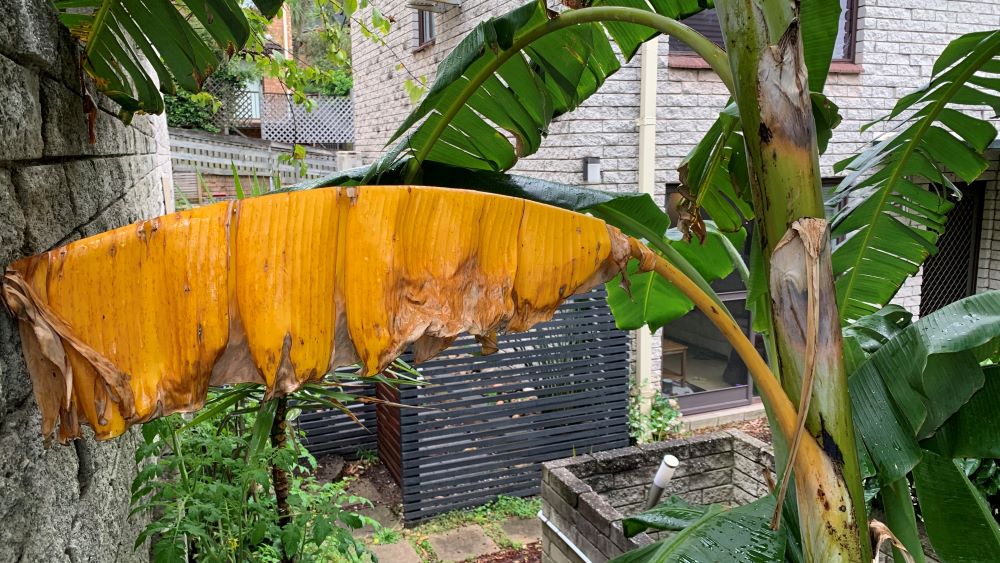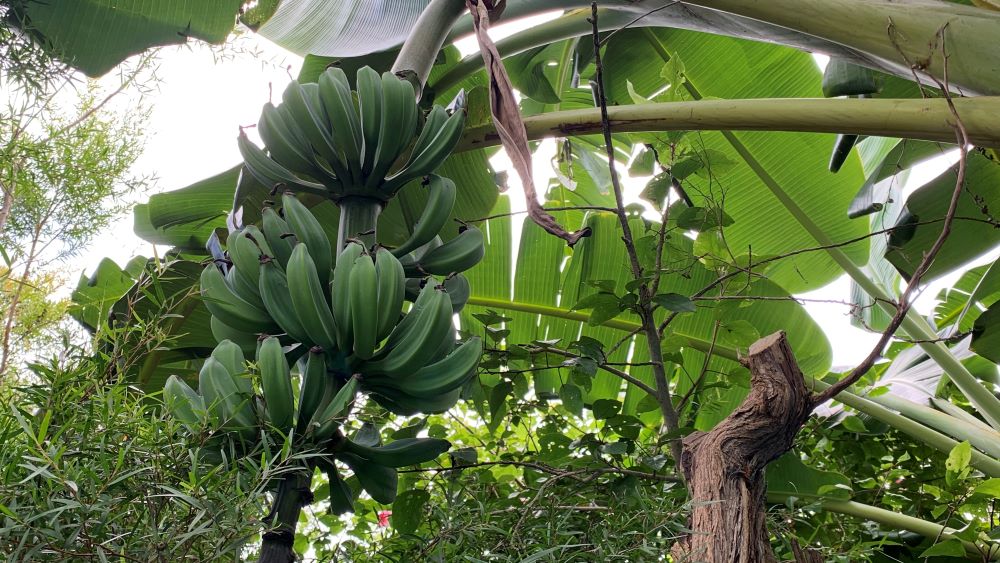Banana plants need a lot of water, but you can also give them too much water if you’re not careful. Overwatered banana plants can develop drooping leaves, yellow leaves, brown leaf tips and the trunk can become heavy and bend.
The good news is, if you’ve noticed that your banana plant has received too much water, there are simple things you can do about it.

Six Signs of an Overwatered Banana Plant
During the growing period, banana plants need a lot of watering, but you can also water these plants too much. If you want to figure out if your own banana plants have received too much water, here are some signs to look for:
1. The Leaves can look Yellow or Brown
Banana plant leaves that have received too much water usually look weak, turn colors such as yellow and even brown, and will start to droop and wilt.
If the leaves start to fall off, it might be too late to rescue them, but it’s likely you’ll notice the condition of the leaves before that happens.

2. The Stem or Base of the Plant Gets Moldy
One of the things you can do if you want to know if your banana plant is overwatered is to look at the base or stem of the plant. Look for algae or mold on the top of the soil.
It might be on the stem of the plant itself, but it’s more likely that any mold or algae will be on the soil instead.
3. Growth will Slow
If the plant has received too much water, it might start to die because the roots are drowning, and they aren’t able to supply water to the upper part of the plant.
This is an indication that the plant is drowning, literally, which isn’t a good sign.

4. The Trunk or Stem Is Soft
If a banana plant has had too much water, the trunk or stem of the plant might become soft. This happens when the plant has so much water that it can no longer support itself. Banana plants can even start to bend and start to collapse.
For more on how to fix a drooping banana plant, check out this article.
5. The Leaves will become Soft
Overwatered banana plants can become too soft simply because they have had too much water. The leaves on the banana plant should be firm to the touch. If the plant has too much water the leaves will droop.
6. Prone to pests and diseases
Overwatered banana plants will be more prone to pets and disease. They can develop brown spots on the leaves, stem rot, root rot or leaf damage. Overwatered banana plants will be more prone to these problems.
4 Ways to Save an Overwatered Banana Plant
While some overwatered banana plants are beyond repair, you can certainly save many of them many circumstances. If you’ve already determined that your banana plant is overwatered, you can try these things to see if they help:
1. Stop Watering the Banana Plant
Stop watering the plant to allow the soil to partially dry out. This can take several days. After 2-3 days you should start to see drooping leaves straighten out.
Once the plant shoes signs of recovery you can return to watering it on a normal schedule.
Keep reading to find out how often to water your banana plant.

2. Repot the Banana Plant
Repot potted banana plants into a bigger pot with fresh potting soil. Water it in and do not add any fertilizer for at least 2 weeks. After this you should see the plant start to develop new leaves and longer stems.
3. Cut off the Damaged Leaves or Stems
If the stems or leaves of the plant are mushy or soft cut them off near the base of the roots and wait a few days. Remove any leaves that have developed brown marks or tears.
Banana plants grow from a rhizome which is a root system that can send up multiple new stems. Removing the old stems will stimulate new growth. If this is done in the warmer months of spring and summer you could even see stems within a few weeks.
My banana plant would send up a new stem within 2 weeks of me cutting an old one off. I like to keep mine to 3-4 main stems. This will allow the plant to focus its energy on a few stems and increase the likelihood of them producing a bunch of bananas.
4. Check the Drainage of the Pot You’re Using
If you’re keeping your banana plant in a pot, it needs to be the right pot. More specifically, you need a pot that drains well and doesn’t cause root rot.
Choose a pot that has at least 5 drainage holes in the base. Outdoor pots can be lifted on pot feet to help the water to drain out easier.
How Often to water a Banana Plant
Water new banana plants every two to three days. Wait until roughly one-half inch to one inch of topsoil is dry before watering again.
If the soil is still damp at the very top, it does not need to be watered. When you water the plant, water it deeply and slowly and make sure the soil drains well.
During the cooler months banana plants will need less water. Banana plants tend to stop growing once the temperature gets below 50 degrees Fahrenheit, which means they will need much less watering.

How to Know if a Banana Plant has Root Rot
Root rot on a banana plant will be noticed first in the leaves, The leaves can yellow or discolor, droop, or wilt. The leaves can become soft or mushy or start to fall off the plant. The leaves might also turn dark brown or reddish-brown, or they could even have a peculiar or unpleasant smell to them.
Root rot is a fungus that grows on the roots casing damage. Reduce watering and repot potted banana plants in fresh soil. Mulch banana plants growing in the ground to help to regulate the amount of rain water reaching the roots.
You can use hay, straw or bark mulch. Layer the mulch 2-3 inches thick around the root zone but away from the stems.
Summary
Banana plants need regular water during the growing season and sometimes need extra water during a drought. When the plant is overwatered, the extra water can cause big problems and possibly even kill the plant. Fortunately, there are a few ways you might be able to save your plant now that you know what they are.
I am an accredited practicing dietitian, experienced gardener and a dedicated cook. I love writing and sharing my experience so you can learn from my successes and mistakes.
